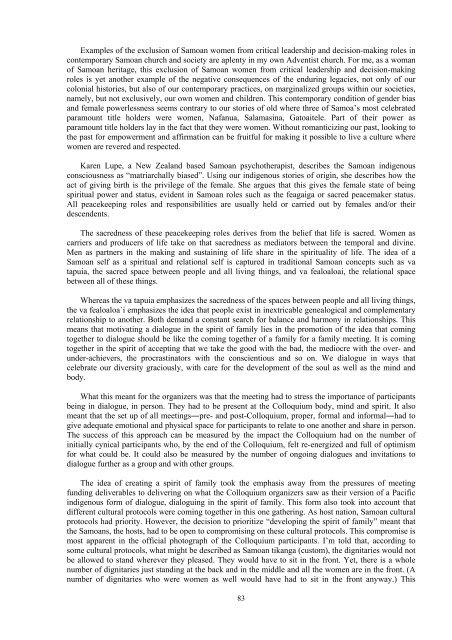traditional knowledge conference 2008 te tatau pounamu
traditional knowledge conference 2008 te tatau pounamu
traditional knowledge conference 2008 te tatau pounamu
You also want an ePaper? Increase the reach of your titles
YUMPU automatically turns print PDFs into web optimized ePapers that Google loves.
Examples of the exclusion of Samoan women from critical leadership and decision-making roles incon<strong>te</strong>mporary Samoan church and society are aplenty in my own Adventist church. For me, as a womanof Samoan heritage, this exclusion of Samoan women from critical leadership and decision-makingroles is yet another example of the negative consequences of the enduring legacies, not only of ourcolonial histories, but also of our con<strong>te</strong>mporary practices, on marginalized groups within our societies,namely, but not exclusively, our own women and children. This con<strong>te</strong>mporary condition of gender biasand female powerlessness seems contrary to our stories of old where three of Samoa’s most celebra<strong>te</strong>dparamount title holders were women, Nafanua, Salamasina, Gatoai<strong>te</strong>le. Part of their power asparamount title holders lay in the fact that they were women. Without romanticizing our past, looking tothe past for empowerment and affirmation can be fruitful for making it possible to live a culture wherewomen are revered and respec<strong>te</strong>d.Karen Lupe, a New Zealand based Samoan psychotherapist, describes the Samoan indigenousconsciousness as “matriarchally biased”. Using our indigenous stories of origin, she describes how theact of giving birth is the privilege of the female. She argues that this gives the female sta<strong>te</strong> of beingspiritual power and status, evident in Samoan roles such as the feagaiga or sacred peacemaker status.All peacekeeping roles and responsibilities are usually held or carried out by females and/or theirdescendents.The sacredness of these peacekeeping roles derives from the belief that life is sacred. Women ascarriers and producers of life take on that sacredness as mediators between the <strong>te</strong>mporal and divine.Men as partners in the making and sustaining of life share in the spirituality of life. The idea of aSamoan self as a spiritual and relational self is captured in <strong>traditional</strong> Samoan concepts such as vatapuia, the sacred space between people and all living things, and va fealoaloai, the relational spacebetween all of these things.Whereas the va tapuia emphasizes the sacredness of the spaces between people and all living things,the va fealoaloa`i emphasizes the idea that people exist in inextricable genealogical and complementaryrelationship to another. Both demand a constant search for balance and harmony in relationships. Thismeans that motivating a dialogue in the spirit of family lies in the promotion of the idea that comingtogether to dialogue should be like the coming together of a family for a family meeting. It is comingtogether in the spirit of accepting that we take the good with the bad, the mediocre with the over- andunder-achievers, the procrastinators with the conscientious and so on. We dialogue in ways thatcelebra<strong>te</strong> our diversity graciously, with care for the development of the soul as well as the mind andbody.What this meant for the organizers was that the meeting had to stress the importance of participantsbeing in dialogue, in person. They had to be present at the Colloquium body, mind and spirit. It alsomeant that the set up of all meetings―pre- and post-Colloquium, proper, formal and informal―had togive adequa<strong>te</strong> emotional and physical space for participants to rela<strong>te</strong> to one another and share in person.The success of this approach can be measured by the impact the Colloquium had on the number ofinitially cynical participants who, by the end of the Colloquium, felt re-energized and full of optimismfor what could be. It could also be measured by the number of ongoing dialogues and invitations todialogue further as a group and with other groups.The idea of creating a spirit of family took the emphasis away from the pressures of meetingfunding deliverables to delivering on what the Colloquium organizers saw as their version of a Pacificindigenous form of dialogue, dialoguing in the spirit of family. This form also took into account thatdifferent cultural protocols were coming together in this one gathering. As host nation, Samoan culturalprotocols had priority. However, the decision to prioritize “developing the spirit of family” meant thatthe Samoans, the hosts, had to be open to compromising on these cultural protocols. This compromise ismost apparent in the official photograph of the Colloquium participants. I’m told that, according tosome cultural protocols, what might be described as Samoan tikanga (custom), the dignitaries would notbe allowed to stand wherever they pleased. They would have to sit in the front. Yet, there is a wholenumber of dignitaries just standing at the back and in the middle and all the women are in the front. (Anumber of dignitaries who were women as well would have had to sit in the front anyway.) This83
















